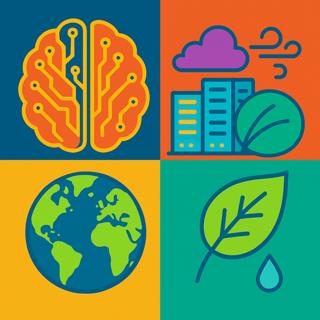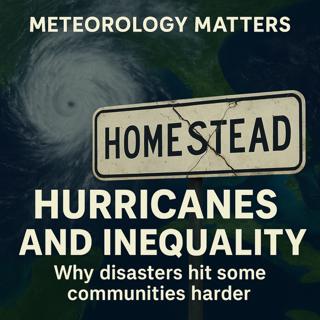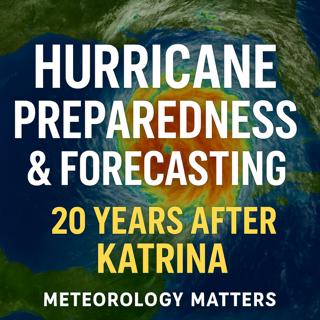
The Environmental Impact of Artificial Intelligence: Energy, Water, and Sustainability
Meteorology Matters is testing episodes in English and Spanish.Seasons 1–100: English EpisodesTemporadas 101–200: Episodios en EspañolThe rapid integration of Artificial Intelligence (AI) into daily life is driving an unprecedented and escalating demand for computational resources, resulting in a significant and growing environmental footprint. This briefing synthesizes key data on AI's consumption of energy and water, its contribution to carbon emissions and e-waste, and the emerging strategies for mitigating these impacts.The core of AI's environmental burden lies in the vast data centers required to train and operate its models. These facilities consumed 4.4% of U.S. electricity in 2023, a figure projected to triple by 2028. Globally, data center electricity consumption is on track to double between 2022 and 2026, reaching a level comparable to the entire nation of Japan. This surge is primarily fueled by generative AI, which requires constant, reliable power, thereby increasing dependence on fossil fuels and locating data centers in regions with higher-carbon energy grids.Beyond electricity, AI's thirst for water to cool its hardware is creating acute, localized crises. Reports indicate that major tech companies' water usage has increased by as much as 34% in a single year, straining municipal supplies, impacting local communities, and sparking protests in regions from the U.S. to South America.A critical challenge in addressing these issues is the pervasive lack of transparency from technology companies, which treat their resource consumption data as trade secrets. This "black box" approach hinders effective regulation, research, and public accountability. In response, legislative and standardization efforts are beginning to emerge in the U.S. and E.U. to mandate reporting.While the energy cost of training models like GPT-4 is immense—estimated at over 50 gigawatt-hours—the majority of AI's energy demand (80-90%) now comes from "inference," the day-to-day use of these models by billions of users. The future trajectory points toward even greater consumption, with the development of AI "agents" and "reasoning models" that could require orders of magnitude more energy. Proposed solutions focus on a multi-pronged strategy: developing more efficient AI models and hardware, transitioning data centers to renewable energy sources, and fostering interdisciplinary research to guide sustainable development.
21 Okt 19min

El impacto ambiental de la inteligencia artificial: energía, agua y sostenibilidad
Meteorology Matters is testing episodes in English and Spanish.Seasons 1–100: English EpisodesTemporadas 101–200: Episodios en EspañolLa rápida integración de la Inteligencia Artificial (IA) en la vida cotidiana está impulsando una demanda creciente y sin precedentes de recursos computacionales, lo que genera una huella ambiental significativa y creciente. Este informe sintetiza datos clave sobre el consumo de energía y agua de la IA, su contribución a las emisiones de carbono y los residuos electrónicos, y las estrategias emergentes para mitigar estos impactos.La principal carga ambiental de la IA reside en los enormes centros de datos necesarios para entrenar y operar sus modelos. Estas instalaciones consumieron el 4,4 % de la electricidad de EE. UU. en 2023, una cifra que se proyecta que se triplicará para 2028. A nivel mundial, el consumo de electricidad de los centros de datos se duplicará entre 2022 y 2026, alcanzando un nivel comparable al de todo Japón. Este aumento se debe principalmente a la IA generativa, que requiere energía constante y fiable, lo que aumenta la dependencia de los combustibles fósiles y obliga a ubicar los centros de datos en regiones con redes eléctricas con mayor contenido de carbono.Más allá de la electricidad, la necesidad de agua de la IA para refrigerar su hardware está generando crisis agudas y localizadas. Los informes indican que el consumo de agua de las principales empresas tecnológicas ha aumentado hasta un 34 % en un solo año, lo que ha sobrecargado los suministros municipales, afectado a las comunidades locales y provocado protestas en regiones desde Estados Unidos hasta Sudamérica.Un desafío crítico para abordar estos problemas es la falta generalizada de transparencia de las empresas tecnológicas, que tratan sus datos de consumo de recursos como secretos comerciales. Este enfoque de "caja negra" obstaculiza la regulación, la investigación y la rendición de cuentas públicas efectivas. En respuesta, están comenzando a surgir iniciativas legislativas y de estandarización en Estados Unidos y la Unión Europea para exigir la presentación de informes.Si bien el costo energético de entrenar modelos como GPT-4 es inmenso (estimado en más de 50 gigavatios-hora), la mayor parte de la demanda energética de la IA (80-90 %) proviene ahora de la "inferencia", el uso diario de estos modelos por parte de miles de millones de usuarios. La trayectoria futura apunta a un consumo aún mayor, con el desarrollo de "agentes" de IA y "modelos de razonamiento" que podrían requerir órdenes de magnitud mayores de energía. Las soluciones propuestas se centran en una estrategia multifacética: desarrollar modelos y hardware de IA más eficientes, trasladar los centros de datos a fuentes de energía renovables y fomentar la investigación interdisciplinaria para guiar el desarrollo sostenible.
21 Okt 21min

Huracanes, Olas de Calor, Tormentas y Desinformación
Bienvenidos a Meteorology Matters en Español, el podcast que explica la ciencia del tiempo y los fenómenos extremos que están cambiando nuestro mundo. Desde olas de calor históricas hasta huracanes que se intensifican rápidamente, aquí encontrarás explicaciones claras, entrevistas con expertos y análisis de cómo estos eventos afectan a nuestras comunidades. Publicado semanalmente, este espacio busca combatir la desinformación y compartir los hechos más importantes sobre la meteorología y sus impactos.En este episodio de Meteorology Matters, analizamos lo último sobre olas de calor extremas, huracanes y patrones cambiantes como La Niña. Exploramos investigaciones innovadoras que vinculan a las compañías de combustibles fósiles con el empeoramiento de las olas de calor, los riesgos de tormentas que se intensifican rápidamente y las batallas políticas que transforman agencias como el DOE y el CDC. Con la desinformación propagándose más rápido que nunca, este resumen aclara la confusión y ofrece los hechos más importantes a finales de 2025. Comienza "Meteorology Matters" serie de podcasts ahora mismo con el episodio 1 de la temporada 101, solo para darle una oportunidad. Cuéntenme qué les parece y si les gustaría que esto continúe, posiblemente convirtiéndose en su propio canal. Dale like, inscríbate, comenta y sigue en redes sociales… Instagram @meteorologistTikTok @TVmeteorologistYouTube @RobJonesHurricane
12 Sep 19min

Hurricane Season Stalls as Ocean Waters Heat Up
In this episode of Meteorology Matters, we break down the latest hurricane season update, science behind extreme weather, from record-breaking heatwaves to rapidly intensifying hurricanes, and explore how shifting ocean patterns like La Niña may shape the months ahead. We also examine the growing battles over science, misinformation, and public trust. Stay informed with the facts that matter most in 2025.
12 Sep 35min

Hurricanes and Inequality: Racism in the Recovery
Hurricanes don’t just destroy buildings, they reshape communities. In this episode of Meteorology Matters, Rob Jones dives into how storms like Andrew, Katrina, and Ian left behind more than physical damage. From South Florida’s racial and ethnic divides, to gentrification in New Orleans, to today’s booming coastal housing markets, we explore how disasters deepen inequality. Who bounces back and who gets left behind?Keywords Hurricane Andrew, Hurricane Katrina, Hurricane Ian, disaster inequality, Florida hurricanes, climate change, housing markets, gentrification, natural disasters, Miami history, racial inequality, hurricane recovery, insurance crisis
1 Sep 42min

Disaster Capitalism in New Orleans: Whitewashed Urban Transformation after Hurricane Katrina
In this episode of Meteorology Matters, we dive into how Hurricane Katrina reshaped New Orleans, not just physically, but politically and economically. We uncover how “disaster capitalism” and neoliberal urban policies turned the city into a laboratory for privatization, gentrification, and displacement. From skyrocketing rents and the demolition of public housing to the cultural erasure of long-time Black residents, New Orleans became a model for how crises can accelerate inequality in American cities.🔑 Keywords: Hurricane Katrina, New Orleans recovery, neoliberal urban policy, disaster capitalism, housing crisis, gentrification, inequality, post-Katrina, public housing, urban planning, disaster recovery, racial inequality.
30 Aug 48min

Hurricane Preparedness & Forecasting 20 Years After Katrina
🌪️ Hurricane Preparedness & Forecasting 20 Years After KatrinaEpisode Description:It’s been 20 years since Hurricane Katrina reshaped the Gulf Coast — and the way we forecast and prepare for hurricanes. In this episode of Meteorology Matters, Rob Jones breaks down how forecasting has improved, where the biggest vulnerabilities remain, and why climate change is making storms more dangerous.You’ll discover:How new satellites and models have cut hurricane track errors by 50% since KatrinaWhy storm surge — not wind — remains the deadliest hurricane threatThe hidden risks in New Orleans’ levee system, still only rated for a Category 3 stormHow rapidly intensifying storms are reducing evacuation timeWhy budget cuts to FEMA and NOAA could stall future forecasting progressWhether you live on the Gulf Coast, the East Coast, or inland, these insights could help you understand the real risks of hurricanes in a warming world — and why preparation matters more than ever.👉 Listen now on Apple Podcasts, Spotify, YouTube, or your favorite app. Don’t forget to follow, rate, and share to help others stay weather-ready.
29 Aug 28min

The Enduring Lessons of Hurricane Katrina and the Current State of U.S. Disaster Preparedness
The Enduring Lessons of Hurricane Katrina and the Current State of U.S. Disaster PreparednessDate: August 25, 2025Twenty years after Hurricane Katrina, its lessons remain profoundly relevant, highlighting systemic failures in national preparedness, coordination, and the critical role of federal agencies. While significant strides have been made in hurricane science and forecasting since 2005, particularly through federally funded initiatives, these gains and the overall U.S. disaster response capability are now critically at risk. Current administrative actions, including budget cuts, leadership inexperience, and a proposed reduction in FEMA's role, threaten to roll back two decades of progress, leaving the nation more vulnerable to increasingly intense and frequent climate-driven disasters. Experts and FEMA staff alike warn that the country is regressing to a "pre-Katrina era" of unpreparedness, with potentially catastrophic consequences.I. Hurricane Katrina: A Catalog of Systemic Failures (2005 Perspective)Hurricane Katrina, making landfall on August 29, 2005, as a Category 3 hurricane near the Louisiana-Mississippi border, was "an extraordinarily powerful and deadly hurricane that carved a wide swath of catastrophic damage and inflicted large loss of life." It became "the costliest and one of the five deadliest hurricanes to ever strike the United States," with a revised death toll of nearly 1,400 and an inflation-adjusted damage estimate of $186.3 billion (NHC, NPR). The federal response was "widely seen as a failure" (Yale Climate Connections), exposing deep-seated flaws across multiple domains.A. Core Failures Identified in "Katrina - Lessons Learned" Report:The Bush administration's "Lessons Learned" report identified 17 critical challenges, underscoring the inadequacy of the existing system for catastrophic threats. B. The Vulnerability of New Orleans:New Orleans was uniquely vulnerable due to its geography (half the city at or below sea level), loss of protective wetlands, and an inadequate levee system that "many scientists thought were too low" (NPR). A 2004 disaster simulation, "Hurricane Pam," predicted "thousands of deaths and that the entire city would be flooded," but federal agencies did not grasp the seriousness (NPR). The catastrophic levee failures, rather than just the storm's intensity, were the primary cause of devastation, overwhelming even more robust defenses in some areas due to "water levels over 27 feet" (Georgia Tech).C. Social and Economic Inequalities:Katrina "exposed and deepened existing social and economic inequalities." Lower-income Black neighborhoods, due to "years of segregation, disinvestment, and discriminatory housing policies," were "uniquely vulnerable" with residents often lacking "access to reliable transportation, making evacuation difficult or impossible." (Georgia Tech)II. Progress Since Katrina: Hurricane Science and ForecastingIn the two decades since Katrina, "hurricane scientists have made great strides toward understanding how climate change influences tropical cyclones, at the same time as they have vastly improved hurricane forecasting" (OPB).III. Current State of Vulnerability: Backsliding Towards a "Pre-Katrina Era" (2025 Perspective)Despite the scientific progress, disaster experts and FEMA staff warn that the U.S. is facing a severe regression in its disaster preparedness and response capabilities, reminiscent of the conditions that exacerbated the Katrina disaster.
25 Aug 31min





















